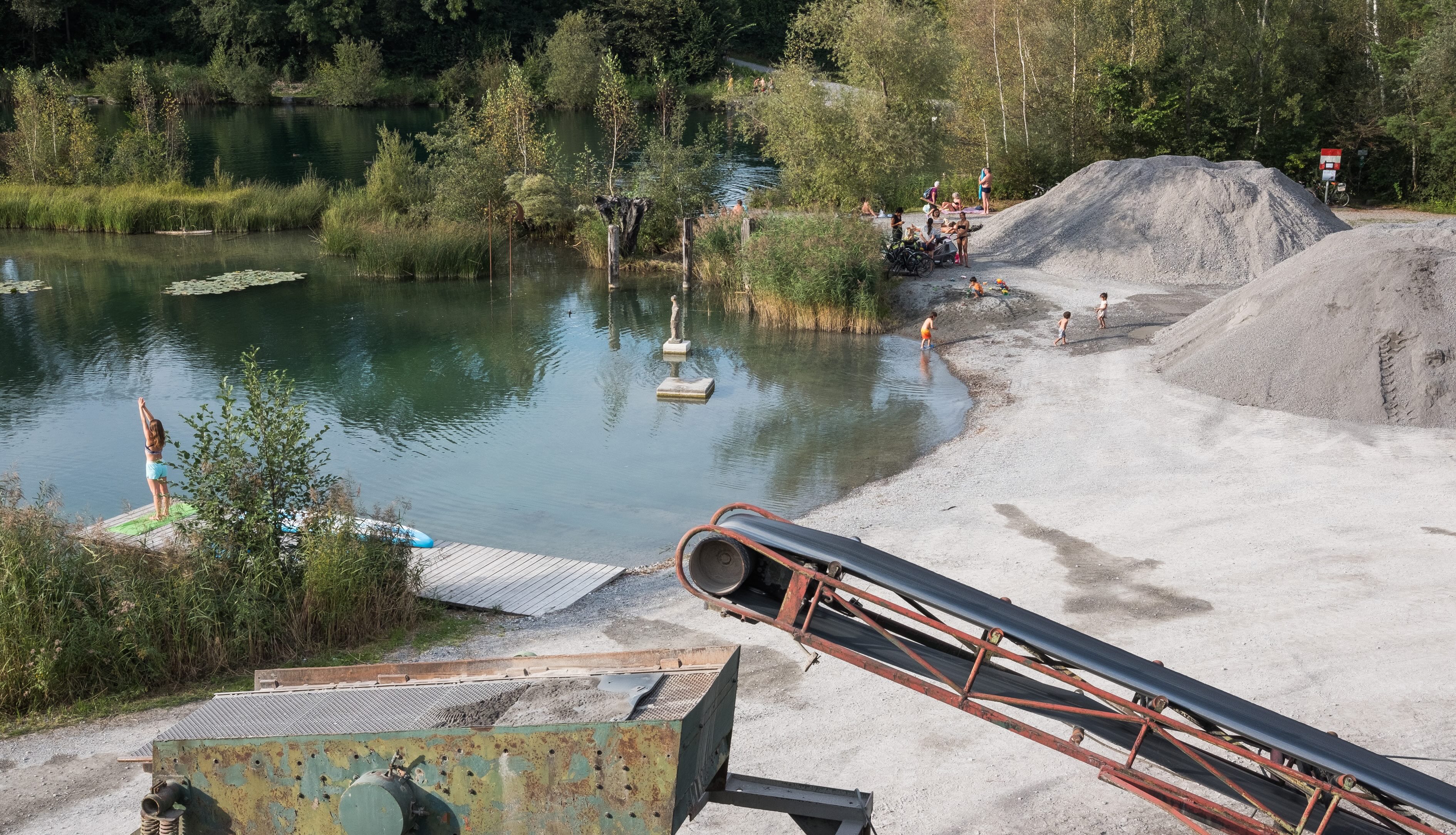Jerzy Nachtman> November 28, 1944
29c Jerzy Nachtman
With the tractor almost across the border: How Jerzy Nachtman, alias Kazimierz Olecki, became a national hero after all
Götzis-Diepoldsau-Basel-Montreux-Geneva, November 28, 1944
When Jerzy Nachtman arrives in Götzis as a civilian worker in November 1944, the 22-year-old has already experienced a lot. He had been fighting in the Polish underground against the German occupation since 1940, on the side of the Catholic nationalist resistance organization NSZ. First in his home town of Wołomin, then in Warsaw. In August 1944, he took part in the Warsaw Uprising as an 'officer cadet' in the 'Warzawianka' unit. However, the uprising was crushed while the Red Army waited on the eastern bank of the Vistula before advancing. The Soviets' interest in a victory for the Polish nationalists is limited.
Jerzy Nachtman, who had fought under the code name Kazimierz Olecki, managed to escape, first to Kraków, then to Częstochowa. There he received false papers, now in the name of Jerzy Zmielinski, with which he reported for work in the German Reich.
Many years later, in 2009, he gave an interview to the Museum of the Warsaw Uprising.
“You could choose where you wanted to go when you volunteered to work in Germany. I had contact with a monk there, and he arranged for me to go to Feldkirch in Germany as a volunteer. This is on the Austrian-Swiss border. I got on a train...
And did you have to go there yourself?
Yes, because I was a volunteer, I wasn't escorted, I just had a ticket, got on the train and traveled. I changed trains in Vienna and made it to the Swiss border. There I reported to the employment office that I had come to work. 'What can you do? I said: 'A bit with a car. I'm a driver. (...)
Afterwards [I] spoke with Poles who had been in captivity since 1939 and then were working there, who said: 'Listen, on the Rhine - (...) the village of Götzis, closer to the border, - you say, you're a tractor driver'. And I say: 'I can't [drive] on a tractor'. - 'Sit down! They showed me how to put the gears in. So I went there and said I was a driver. There was a pontoon factory at the border and I drove there for two or three days. Later I found out from this Pole that the border ran along the Rhine, but at one point the Rhine changed its bed and there was a dry land border.
He said, 'Listen, I'm going to plow a field of the local community on this border. I'm going to get sick and you can come there and try to escape'. And that's what I did. (...) And it turned out that there was a dam and a guardhouse every two or three hundred meters, and guards inside. And yet he told me: 'If you're on the embankment, they can't shoot because they could shoot a Swiss'. So I went there, picked up this plow, and it drizzled. (...) When the Germans realized that I was working, they didn't pay any attention. I drove up between the guard posts under the dam, I left the tractor, [the engine] stuttered, [I jumped] onto the dam, and I didn't know that there were wires behind the dam, racks with barbed wire, but in fear I tore myself away, jumped over and there I was in Switzerland.”[1]
Jerzy Nachtman reaches the streetcar, which at that time still ran from Diepoldsau to Heerbrugg, without any obstacles. The conductor doesn't want his money, but the Swiss police are already waiting at the bridge over the Rhine. Nachtman is transferred to a camp for military internees in Basel. He escapes from there on the very first morning and is caught again. He also succeeds in escaping from the next camp, this time near Montreux on Lake Geneva, only to end up in a camp in Geneva again, under more severe conditions.
“You gave the Swiss a lot of pleasure.
But when they caught me in Geneva, they already knew I was on the run, I was sitting at the [police] station, they came and checked to see if I was hungry, they gave me magazines.
So with sympathy.
Yes. Then they deported me to a camp for Polish soldiers, because in 1940 the division that had fought in France didn't lay down its arms, but went to Switzerland and the Swiss interned them.”
However, after Nachtman escapes for the third time, he is interned in a camp that is more strictly guarded, with dogs and barbed wire. Officers are among the internees and Nachtman actually meets his cousin Stefan Wiązowski, who advises him against rash actions. Wiązowski now has a secret Swiss girlfriend. Together they manage to escape to France, where Nachtman rejoins the Polish army in January and is stationed in Italy during the final months of the war.
Nachtman did not return home until 1946. Under communist rule, his courageous actions during the war no longer count for anything; he has fought on the wrong side of the resistance. It was not until after 1989 that the wind changed and Nachtman was appropriated by the new Polish nationalism, becoming a decorated national hero and a sought-after contemporary witness in schools.[2]
[1] Interview with Jerzy Nachtman, October 17, 2009, on the website of the Museum of the Warsaw Uprising: https://www.1944.pl/archiwum-historii-mowionej/jerzy-henryk-nachtman,2051.html (3.2.2025).
[2] More on Jerzy Nachtman: https://www.hohenemsgenealogie.at/getperson.php?personID=I58559&tree=Hohenems
29c Jerzy Nachtman
With the tractor almost across the border: How Jerzy Nachtman, alias Kazimierz Olecki, became a national hero after all
Götzis-Diepoldsau-Basel-Montreux-Geneva, November 28, 1944
When Jerzy Nachtman arrives in Götzis as a civilian worker in November 1944, the 22-year-old has already experienced a lot. He had been fighting in the Polish underground against the German occupation since 1940, on the side of the Catholic nationalist resistance organization NSZ. First in his home town of Wołomin, then in Warsaw. In August 1944, he took part in the Warsaw Uprising as an 'officer cadet' in the 'Warzawianka' unit. However, the uprising was crushed while the Red Army waited on the eastern bank of the Vistula before advancing. The Soviets' interest in a victory for the Polish nationalists is limited.
Jerzy Nachtman, who had fought under the code name Kazimierz Olecki, managed to escape, first to Kraków, then to Częstochowa. There he received false papers, now in the name of Jerzy Zmielinski, with which he reported for work in the German Reich.
Many years later, in 2009, he gave an interview to the Museum of the Warsaw Uprising.
“You could choose where you wanted to go when you volunteered to work in Germany. I had contact with a monk there, and he arranged for me to go to Feldkirch in Germany as a volunteer. This is on the Austrian-Swiss border. I got on a train...
And did you have to go there yourself?
Yes, because I was a volunteer, I wasn't escorted, I just had a ticket, got on the train and traveled. I changed trains in Vienna and made it to the Swiss border. There I reported to the employment office that I had come to work. 'What can you do? I said: 'A bit with a car. I'm a driver. (...)
Afterwards [I] spoke with Poles who had been in captivity since 1939 and then were working there, who said: 'Listen, on the Rhine - (...) the village of Götzis, closer to the border, - you say, you're a tractor driver'. And I say: 'I can't [drive] on a tractor'. - 'Sit down! They showed me how to put the gears in. So I went there and said I was a driver. There was a pontoon factory at the border and I drove there for two or three days. Later I found out from this Pole that the border ran along the Rhine, but at one point the Rhine changed its bed and there was a dry land border.
He said, 'Listen, I'm going to plow a field of the local community on this border. I'm going to get sick and you can come there and try to escape'. And that's what I did. (...) And it turned out that there was a dam and a guardhouse every two or three hundred meters, and guards inside. And yet he told me: 'If you're on the embankment, they can't shoot because they could shoot a Swiss'. So I went there, picked up this plow, and it drizzled. (...) When the Germans realized that I was working, they didn't pay any attention. I drove up between the guard posts under the dam, I left the tractor, [the engine] stuttered, [I jumped] onto the dam, and I didn't know that there were wires behind the dam, racks with barbed wire, but in fear I tore myself away, jumped over and there I was in Switzerland.”[1]
Jerzy Nachtman reaches the streetcar, which at that time still ran from Diepoldsau to Heerbrugg, without any obstacles. The conductor doesn't want his money, but the Swiss police are already waiting at the bridge over the Rhine. Nachtman is transferred to a camp for military internees in Basel. He escapes from there on the very first morning and is caught again. He also succeeds in escaping from the next camp, this time near Montreux on Lake Geneva, only to end up in a camp in Geneva again, under more severe conditions.
“You gave the Swiss a lot of pleasure.
But when they caught me in Geneva, they already knew I was on the run, I was sitting at the [police] station, they came and checked to see if I was hungry, they gave me magazines.
So with sympathy.
Yes. Then they deported me to a camp for Polish soldiers, because in 1940 the division that had fought in France didn't lay down its arms, but went to Switzerland and the Swiss interned them.”
However, after Nachtman escapes for the third time, he is interned in a camp that is more strictly guarded, with dogs and barbed wire. Officers are among the internees and Nachtman actually meets his cousin Stefan Wiązowski, who advises him against rash actions. Wiązowski now has a secret Swiss girlfriend. Together they manage to escape to France, where Nachtman rejoins the Polish army in January and is stationed in Italy during the final months of the war.
Nachtman did not return home until 1946. Under communist rule, his courageous actions during the war no longer count for anything; he has fought on the wrong side of the resistance. It was not until after 1989 that the wind changed and Nachtman was appropriated by the new Polish nationalism, becoming a decorated national hero and a sought-after contemporary witness in schools.[2]
[1] Interview with Jerzy Nachtman, October 17, 2009, on the website of the Museum of the Warsaw Uprising: https://www.1944.pl/archiwum-historii-mowionej/jerzy-henryk-nachtman,2051.html (3.2.2025).
[2] More on Jerzy Nachtman: https://www.hohenemsgenealogie.at/getperson.php?personID=I58559&tree=Hohenems

